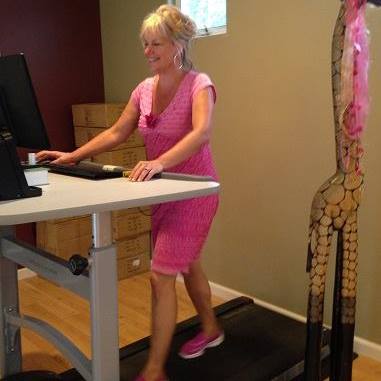
New studies show that sitting for too long can impair health and even shorten life expectancy. It’s difficult to keep active in a world of screens, movie theaters, and desk jobs. However, studies are showing that body awareness and movement is necessary. The goal is to get up at least every hour of sedentary time, to improve posture and metabolic rate.
Medical News Today published an article on proper posture while sitting, showing just how difficult it is to maintain good postural health, with over ten variables to consider. Sitting and staying in one position for more than an hour increases the likelihood of poor posture, decreased metabolism, and inhibits blood flow, which can worsen circulation problems for people with diabetes.
Here are several strategies to lessen their sedentary time and get healthier:
1. Standing Desk/Treadmill Desk
Office Fitness Industry News encourages employers to spend their wellness funds on standing desks or treadmill desks, rather than spending money on a wellness program that offers employees under-utilized gym memberships.
Standing desks help improve posture by allowing people to stand, stretch, and interrupt their sitting time. Simply standing more can help tone muscle, increase metabolism, and prevent diabetes complications. However, some may have difficulty standing for long periods of time. A treadmill desk may feel more natural and compounds the benefits of standing desk: burning extra calories, increasing creativity in the workplace, and potentially even increasing mental acuity for kinesthetic learners or those with ADD.
Even if an employer won’t provide a standing or treadmill desk, just standing up every hour helps counteract a lot of the issues associated with sitting too much.
2. HIIT It!
Taking brief exercise breaks during the day can help tremendously. It doesn’t require going to the gym, or even using your full 10 – 15 minutes in the morning or afternoon. HIIT, or High Intensity Interval Training, only needs to be done in 30 second bursts to be effective. This can include 30 seconds of sprinting in place or doing quick push-ups against a counter (such as in a break room or bathroom). You can find more HIIT exercises that can be done in just 30 seconds, here.
3. Take More Breaks
Many people may only get two 10-15 minute breaks per day plus lunch, but that doesn’t mean they have to be chained to a desk at all other times. Refilling water bottles or glasses every hour can help interrupt sitting and also offer a refreshing mental break from staring at a screen or papers. If the job requires reviewing or reading documents, try doing this while standing or pacing to interrupt the monotony of sitting.
4. Treat the Feet
Suddenly switching from sitting to standing can be tough on lower extremities, and for those already standing most of the day because of their job, proper foot care is important to lessen fatigue and prevent ending the day on the couch until bed.
Wearing thicker socks and cushioned sole inserts can help during the day. Ending the day with an Epsom salt foot bath and lotion can help ease soreness, increase circulation, and help you get back on feet the next day.
5. Stay NEAT
NEAT means non-exercise activity thermogenesis. All it requires is simple stretches, twists, and bends to break up your sitting every hour. Practicing NEAT helps increase circulation, ease back pain and muscle aches, and increase daily range of motion, which will eventually make getting nore active easier too.
Staying mindful about sitting duration and taking any of these steps to move more can help lead to a longer and better quality of life. To see more on how to counteract or avoid sitting disease, see Just Stand’s Office, School, and Home resources.
See our Exercise Resource Page for a bunch of wonderful handouts and movement ideas.









